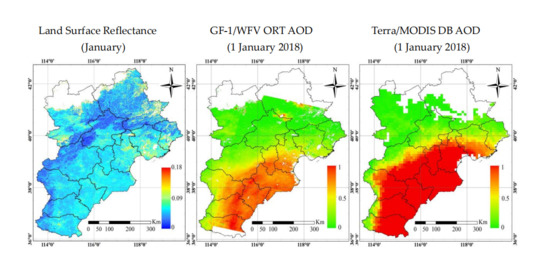An Improved Method for Retrieving Aerosol Optical Depth Using Gaofen-1 WFV Camera Data
Abstract
1. Introduction
2. Data
2.1. GF-1/WFV
2.2. Other Satellite Products
3. AOD Retrieval Algorithm
3.1. Deep Blue (DB) Algorithm
3.2. Data Preprocessing
3.2.1. Angle Calculation
3.2.2. Appropriate Pixel Selection
3.3. Reflectance Relationship Transformation
4. Results and Analysis
4.1. Land Surface Reflectance
4.2. Spatial Distributions of AODs
4.3. AOD Validation Using AERONET Data
5. Conclusions
- In terms of spatial distribution, our AOD_WORT results were roughly consistent with Terra/MODIS and Himawari-8/AHI AOD retrievals based on different AOD retrieval algorithms. GF-1/WFV AOD with a higher spatial resolution of 500 m can provide more abundant details of spatial variation than Terra/MODIS and Himawari-8/AHI.
- The validation results showed that the AOD_WORT had a good correlation and accuracy with AOD_AERO. Especially, our AOD_WORT retrieval algorithm could effectively reduce the overvaluation of AOD_WMRT at low levels of AOD. Generally, RORT (0.88) > RMRT (0.79), RMSEORT (0.13) < RMSEMRT (0.19), and MAEORT (0.1) < MAEMRT (0.15).
- The near-real-time inversion of AOD based on the LSR dataset of last three years also performed excellently both in terms of the spatial distribution and the quantitative comparison with AERONET observations. The high correlation with AERONET AOD (RORT = 0.94), the low RMSE (RMSEORT = 0.11) and the low MAE (MAEORT = 0.09) could certificate the reliability of our AOD_WORT retrieval algorithm.
- Although there was no detailed comparison of inversion effects between rural and urban backgrounds, the smoothing effect on the spatial distribution could confirm that the presence of urban bright surfaces would not cause high values or noises.
Author Contributions
Funding
Institutional Review Board Statement
Informed Consent Statement
Data Availability Statement
Conflicts of Interest
References
- IPCC. Climate Change 2007—The Physical Science Basis; Cambridge University Press: Cambridge, UK, 2007. [Google Scholar]
- Kaufman, Y.J.; Tanre, D.; Boucher, O. A satellite view of aerosols in the climate system. Nature 2002, 419, 215–223. [Google Scholar] [CrossRef] [PubMed]
- Koren, I.; Feingold, G. Aerosol-cloud-precipitation system as a predator-prey problem. Proc. Natl. Acad. Sci. USA 2011, 108, 12227–12232. [Google Scholar] [CrossRef] [PubMed]
- Pope Iii, C.A.; Burnett, R.T.; Thun, M.J.; Calle, E.E.; Krewski, D.; Ito, K.; Thurston, G.D. Lung cancer, cardiopulmonary mortality, and long-term exposure to fine particulate air pollution. JAMA J. Am. Med. Assoc. 2002, 287, 1132–1141. [Google Scholar] [CrossRef] [PubMed]
- Levy, R.C.; Remer, L.A.; Mattoo, S.; Vermote, E.F.; Kaufman, Y.J. Second-generation operational algorithm: Retrieval of aerosol properties over land from inversion of Moderate Resolution Imaging Spectroradiometer spectral reflectance. J. Geophys. Res. Space Phys. 2007, 112. [Google Scholar] [CrossRef]
- Georgoulias, A.K.; Alexandri, G.; Kourtidis, K.; Lelieveld, J.; Zanis, P.; Amiridis, V. Differences between the MODIS Collection 6 and 5.1 aerosol datasets over the greater Mediterranean region. Atmos. Environ. 2016, 147, 310–319. [Google Scholar] [CrossRef]
- Levy, R.C.; Munchak, L.A.; Mattoo, S.K.; Patadia, F.; Remer, L.A.; Holz, R.E. Towards a long-term global aerosol optical depth record: Applying a consistent aerosol retrieval algorithm to MODIS and VIIRS-observed reflectance. Atmos. Meas. Tech. 2015, 8, 4083–4110. [Google Scholar] [CrossRef]
- Sayer, A.M.; Hsu, N.C.; Bettenhausen, C.; Jeong, M.J. Validation and uncertainty estimates for MODIS Collection 6 “Deep Blue” aerosol data. J. Geophys. Res. Atmos. 2013, 118, 7864–7872. [Google Scholar] [CrossRef]
- Tao, M.; Chen, L.; Wang, Z.; Tao, J.; Che, H.; Wang, X.; Wang, Y. Comparison and evaluation of the MODIS Collection 6 aerosol data in China. J. Geophys. Res. Atmos. 2015, 120, 6992–7005. [Google Scholar] [CrossRef]
- Wang, Q.; Sun, L.; Wei, J.; Yang, Y.; Li, R.; Liu, Q.; Chen, L. Validation and Accuracy Analysis of Global MODIS Aerosol Products over Land. Atmosphere 2017, 8, 155. [Google Scholar] [CrossRef]
- Remer, L.A.; Kaufman, Y.J.; Tanré, D.; Mattoo, S.; Chu, D.A.; Martins, J.V.; Li, R.R.; Ichoku, C.; Levy, R.C.; Kleidman, R.G.; et al. The MODIS aerosol algorithm, products, and validation. J. Atmos. Sci. 2005, 62, 947–973. [Google Scholar] [CrossRef]
- Hsu, N.C.; Tsay, S.-C.; King, M.D.; Herman, J.R. Deep Blue Retrievals of Asian Aerosol Properties During ACE-Asia. IEEE Trans. Geosci. Remote Sens. 2006, 44, 3180–3195. [Google Scholar] [CrossRef]
- Hsu, N.C.; Tsay, S.-C.; King, M.D.; Herman, J.R. Aerosol Properties Over Bright-Reflecting Source Regions. IEEE Trans. Geosci. Remote Sens. 2004, 42, 557–569. [Google Scholar] [CrossRef]
- Nichol, J.; Bilal, M. Validation of a Simplified Aerosol Retrieval Algorithm (SARA) over Beijing. Remote Sens. Environ. 2014, 153, 50–60. [Google Scholar]
- Wei, J.; Huang, B.; Sun, L.; Zhang, Z.; Wang, L.; Bilal, M. A Simple and Universal Aerosol Retrieval Algorithm for Landsat Series Images Over Complex Surfaces. J. Geophys. Res. Atmos. 2017, 122, 13–338. [Google Scholar] [CrossRef]
- Sun, K.; Chen, X.; Zhu, Z.; Zhang, T. High Resolution Aerosol Optical Depth Retrieval Using Gaofen-1 WFV Camera Data. Remote Sens. 2017, 9, 89. [Google Scholar] [CrossRef]
- Arvani, B.; Pierce, R.B.; Lyapustin, A.I.; Wang, Y.; Teggi, S.; Ghermandi, G. Application of MAIAC High Spatial Resolution Aerosol Retrievals over Po Valley (Italy). In Remote Sensing of Clouds and the Atmosphere XVIII and Optics in Atmospheric Propagation and Adaptive Systems XVI; International Society for Optics and Photonics: Bellingham, WA, USA, 2013; Volume 8890, p. 88900. [Google Scholar]
- Li, C.; Lau, A.K.; Mao, J.; Chu, D. Retrieval, validation, and application of the 1-km aerosol optical depth from MODIS measurements over Hong Kong. IEEE Trans. Geosci. Remote Sens. 2005, 43, 2650–2658. [Google Scholar] [CrossRef]
- Li, Y.; Xue, Y.; He, X.; Guang, J. High-resolution aerosol remote sensing retrieval over urban areas by synergetic use of HJ-1 CCD and MODIS data. Atmos. Environ. 2011, 46, 173–180. [Google Scholar] [CrossRef]
- Man, S.; Nichol, J.; Lee, K. Retrieval of Aerosol Optical Thickness Using MODIS 500 × 500 m(2), a Study in Hong Kong and the Pearl River Delta Region. IEEE Trans. Geosci. Remote Sens. 2010, 48, 3318–3327. [Google Scholar]
- Wang, Y.; Chen, L.; Chen, L.; Wang, X.; Yu, C.; Si, Y.; Zhang, Z. Interference of Heavy Aerosol Loading on the VIIRS Aerosol Optical Depth (AOD) Retrieval Algorithm. Remote Sens. 2017, 9, 397. [Google Scholar] [CrossRef]
- Tian, X.; Liu, Q.; Song, Z.; Dou, B.; Li, X. Aerosol Optical Depth Retrieval from Landsat 8 OLI Images Over Urban Areas Supported by MODIS BRDF/Albedo Data. IEEE Geosci. Remote Sens. Lett. 2018, 15, 976–980. [Google Scholar] [CrossRef]
- Sun, L.; Wei, J.; Bilal, M.; Tian, X.; Jia, C.; Guo, Y.; Mi, X. Aerosol Optical Depth Retrieval over Bright Areas Using Landsat 8 OLI Images. Remote Sens. 2015, 8, 23. [Google Scholar] [CrossRef]
- Picon, A.; Madhavan, B.; Gross, B.; Moshary, F.; Ahmed, S. Quantification and Assessment of Urban Surface Reflection Ratios and their Effect on Aerosol Retrieval using High Spatial Resolution LANDSAT Retrievals. In Remote Sensing for Agriculture, Ecosystems, and Hydrology XII; International Society for Optics and Photonics: Bellingham, WA, USA, 2010; Volume 7824, p. 782402. [Google Scholar]
- Bilal, M.; Qiu, Z. Aerosol Retrievals Over Bright Urban Surfaces Using Landsat 8 Images. In Proceedings of the IGARSS 2018—2018 IEEE International Geoscience and Remote Sensing Symposium, Valencia, Spain, 22–27 July 2018; pp. 7560–7563. [Google Scholar]
- Zhang, L.; Xu, S.; Wang, L.; Cai, K.; Ge, Q. Retrieval and Validation of Aerosol Optical Depth by using the GF-1 Remote Sensing Data. In Proceedings of the IOP Conference Series: Earth and Environmental Science, Zvenigorod, Russia, 4–7 September 2017; Volume 68, p. 12001. [Google Scholar]
- Zhang, T.; Zhu, Z.; Gong, W.; Zhu, Z.; Sun, K.; Wang, L.; Huang, Y.; Mao, F.; Shen, H.; Li, Z.; et al. Estimation of ultrahigh resolution PM2.5 concentrations in urban areas using 160 m Gaofen-1 AOD retrievals. Remote Sens. Environ. 2018, 216, 91–104. [Google Scholar] [CrossRef]
- Zhu, W.; Zheng, T.; Zhang, L.; Wang, L.; Cai, K. The Retrieval of Aerosol over Land Surface from GF-1 16m Camera with Deep Blue Algorithm. In Proceedings of the IOP Conference Series: Earth and Environmental Science, Zvenigorod, Russia, 4–7 September 2017; Volume 100, p. 12093. [Google Scholar]
- Martins, V.S.; Barbosa, C.C.F.; De Carvalho, L.S.; Jorge, D.S.F.; Lobo, F.D.L.; Novo, E.M.L.D.M. Assessment of Atmospheric Correction Methods for Sentinel-2 MSI Images Applied to Amazon Floodplain Lakes. Remote Sens. 2017, 9, 322. [Google Scholar] [CrossRef]
- Zhang, Z.; Wu, W.; Fan, M.; Tao, M.; Wei, J.; Jin, J.; Wang, Q. Validation of Himawari-8 aerosol optical depth retrievals over China. J. Atmos. Environ. 2019, 199, 32–44. [Google Scholar] [CrossRef]
- Kaufman, Y.J.; Tanré, D.; Remer, L.A.; Vermote, E.F.; Chu, A.; Holben, B.N. Operational remote sensing of tropospheric aerosol over land from EOS moderate resolution imaging spectroradiometer. J. Geophys. Res. Space Phys. 1997, 102, 17051–17067. [Google Scholar] [CrossRef]
- Li, Y.; Zhang, Y.; Tao, C.; Zhu, H. Content-based high-resolution remote sensing image retrieval via unsupervised feature learning and collaborative affinity metric fusion. Remote Sens. Technol. Appl. 2016, 31, 709. [Google Scholar] [CrossRef]
- King, M.D.; Kaufman, Y.J.; Tanré, D.; Nakajima, T. Remote Sensing of Tropospheric Aerosols from Space: Past, Present, and Future. Bull. Am. Meteorol. Soc. 1999, 80, 2229–2259. [Google Scholar] [CrossRef]
- Yang, F.; Wang, Y.; Tao, J.; Wang, Z.; Fan, M.; De Leeuw, G.; Chen, L. Preliminary Investigation of a New AHI Aerosol Optical Depth (AOD) Retrieval Algorithm and Evaluation with Multiple Source AOD Measurements in China. Remote Sens. 2018, 10, 748. [Google Scholar] [CrossRef]
- Yoshida, M.; Kikuchi, M.; Nagao, T.M.; Murakami, H.; Nomaki, T.; Higurashi, A. Common Retrieval of Aerosol Properties for Imaging Satellite Sensors. J. Meteorol. Soc. Jpn. 2018. [Google Scholar] [CrossRef]
- Holben, B.; Eck, T.; Slutsker, I.; Tanré, D.; Buis, J.; Setzer, A.; Vermote, E.; Reagan, J.; Kaufman, Y.; Nakajima, T.; et al. AERONET—A Federated Instrument Network and Data Archive for Aerosol Characterization. Remote Sens. Environ. 1998, 66, 1–16. [Google Scholar] [CrossRef]
- Holben, B.N.; Tanré, D.; Smirnov, A.; Eck, T.F.; Slutsker, I.; Abuhassan, N.; Newcomb, W.W.; Schafer, J.S.; Chatenet, B.; Lavenu, F.; et al. An emerging ground-based aerosol climatology: Aerosol optical depth from AERONET. J. Geophys. Res. Space Phys. 2001, 106, 12067–12097. [Google Scholar] [CrossRef]
- Vermote, E.F.; El Saleous, N.; Justice, C.; Kaufman, Y.J.; Privette, J.L.; Remer, L.; Roger, J.C.; Tanré, D. Atmospheric correction of visible to middle-infrared EOS-MODIS data over land surfaces: Background, operational algorithm and validation. J. Geophys. Res. Space Phys. 1997, 102, 17131–17141. [Google Scholar] [CrossRef]
- Vermote, E.F.; Tanre, D.; Deuze, J.L.; Herman, M.; Morcette, J.-J. Second Simulation of the Satellite Signal in the Solar Spectrum, 6S: An overview. IEEE Trans. Geosci. Remote Sens. 1997, 35, 675–686. [Google Scholar] [CrossRef]
- Kotchenova, S.Y.; Vermote, E.F.; Matarrese, R.; Klemm, J.F.J. Validation of a vector version of the 6S radiative transfer code for atmospheric correction of satellite data Part I: Path radiance. Appl. Opt. 2006, 45, 6762–6774. [Google Scholar] [CrossRef]
- Dubovik, O.; Holben, B.; Eck, T.F.; Smirnov, A.; Kaufman, Y.J.; King, M.D.; Tanré, D.; Slutsker, I. Variability of Absorption and Optical Properties of Key Aerosol Types Observed in Worldwide Locations. J. Atmos. Sci. 2002, 59, 590–608. [Google Scholar] [CrossRef]
- Jacobson, M.Z. Fundamentals of Atmospheric Modeling, 2nd ed.; Cambridge University Press: Cambridge, UK, 2005; Volume 317. [Google Scholar]
- Martins, J.V.; Tanre, D.; Remer, L.; Kaufman, Y.; Mattoo, S.; Levy, R. MODIS Cloud screening for remote sensing of aerosols over oceans using spatial variability. Geophys. Res. Lett. 2002, 29. [Google Scholar] [CrossRef]
- Yun, Y.; Xia, Y.; Zhang, J.; Pan, Y. Cloud and Cloud Shadow Detection in GF-1 Imagery Using Single-data Method. Remote Sens. Inf. 2017, 32, 35–40. [Google Scholar]
- Shams, S.B.; Mohammadzadeh, A. A Novel Aerosol Load Index Using MODIS Visible Bands: Applied to South-West Part of Iran. IEEE J. Sel. Top. Appl. Earth Obs. Remote Sens. 2015, 8, 1167–1175. [Google Scholar] [CrossRef]
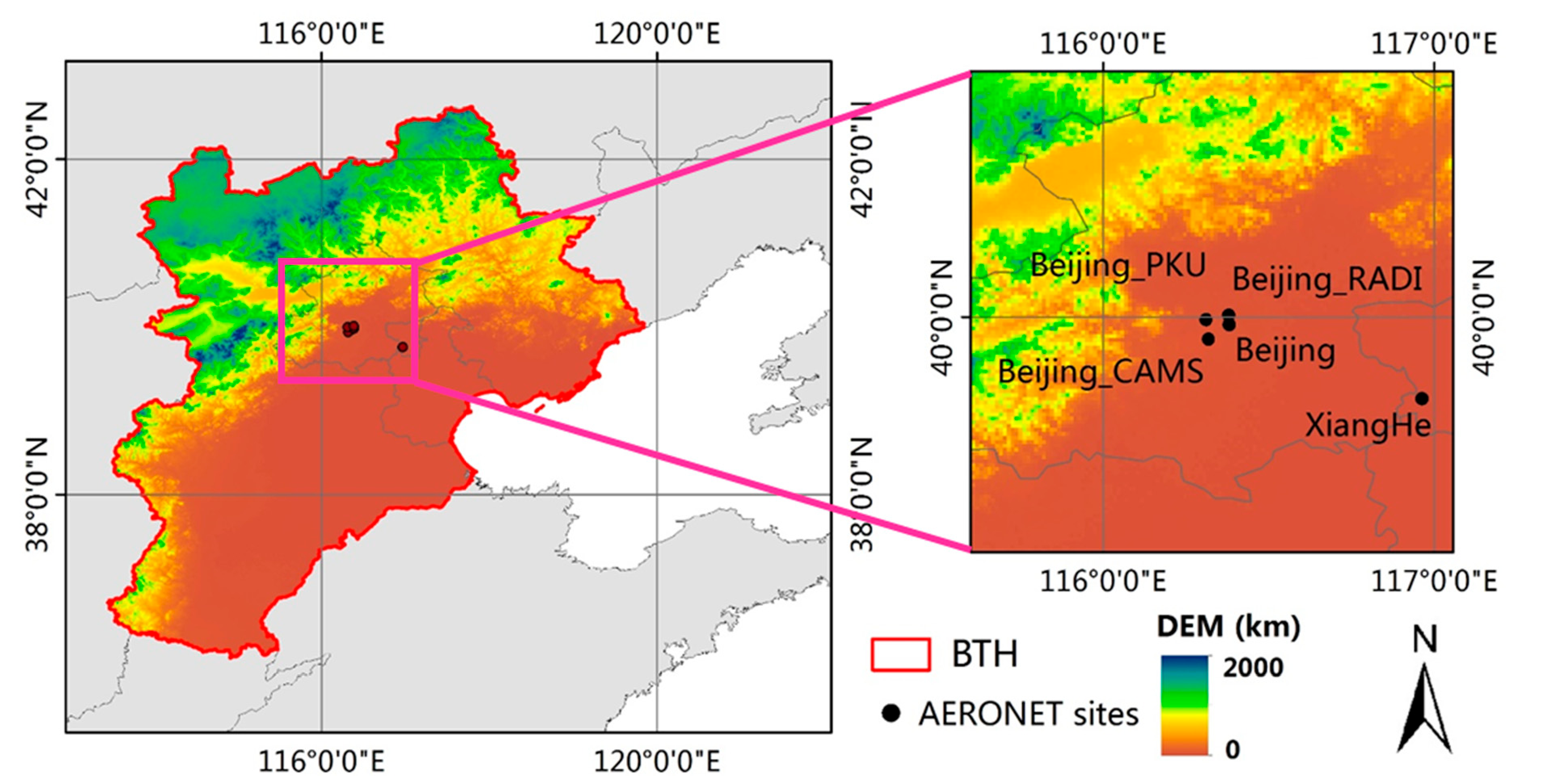

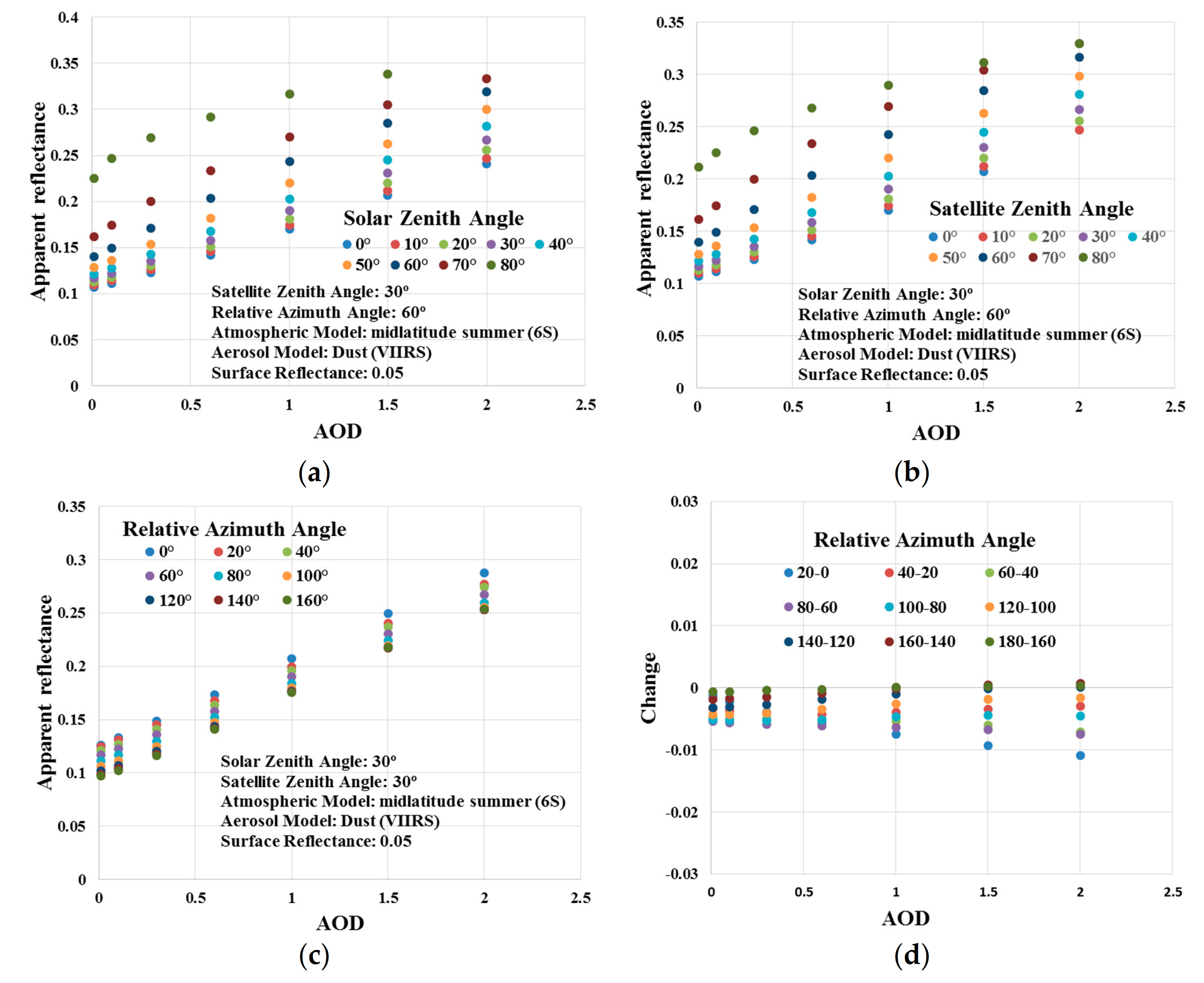
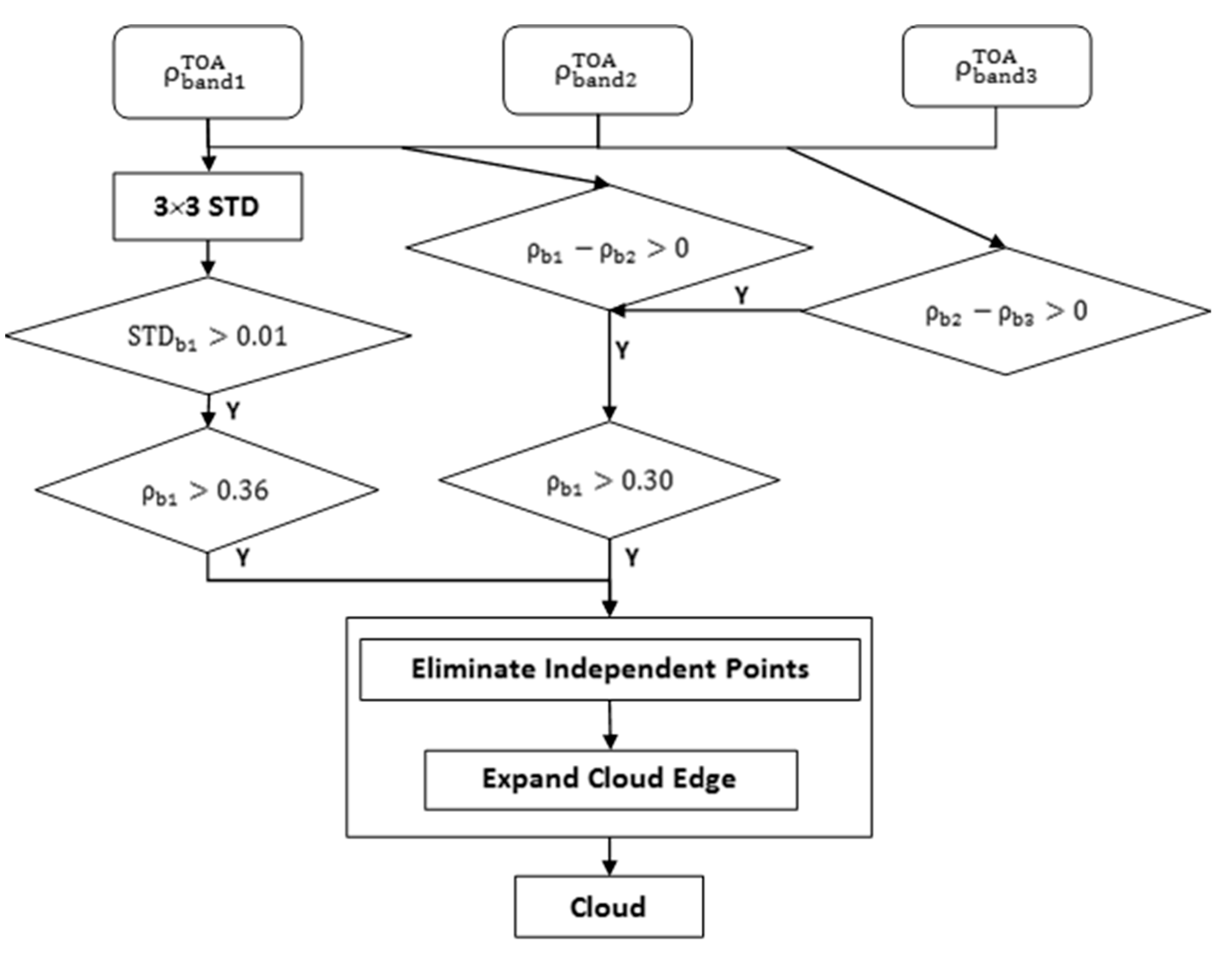
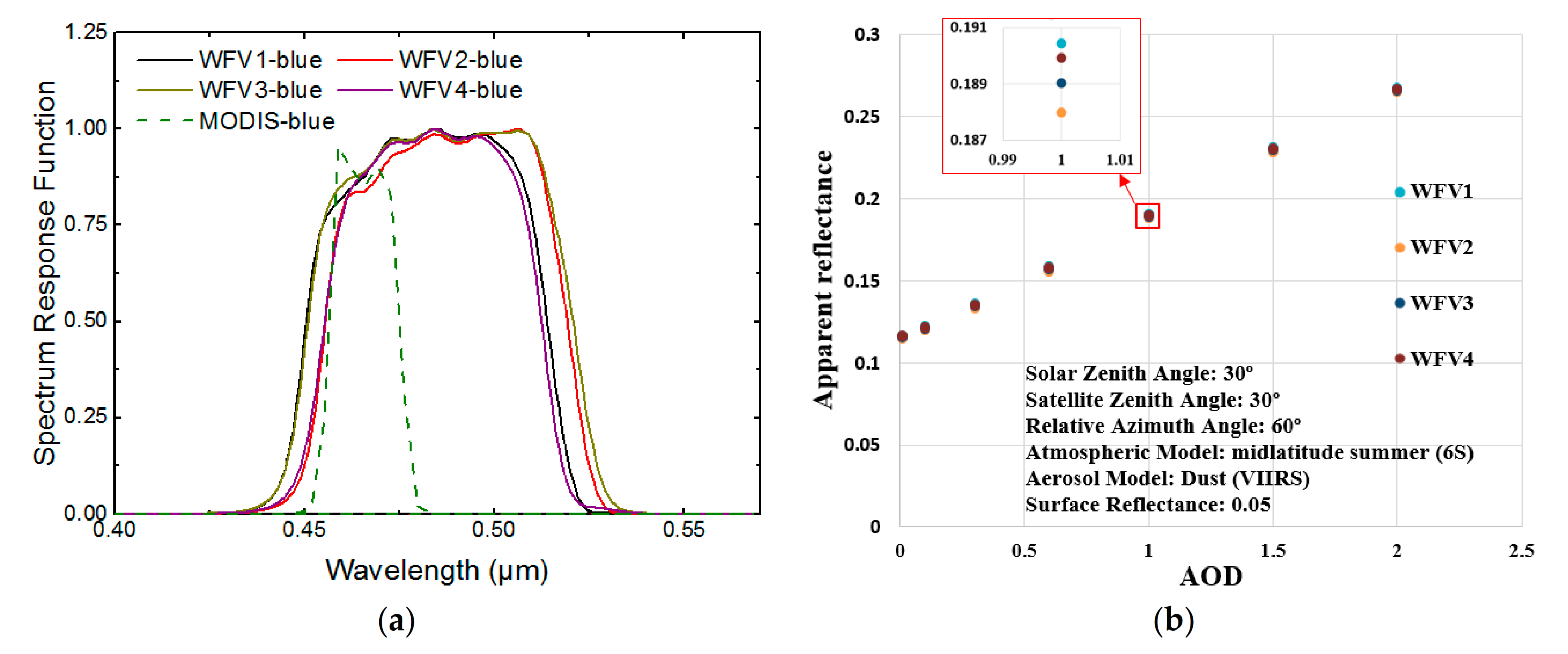
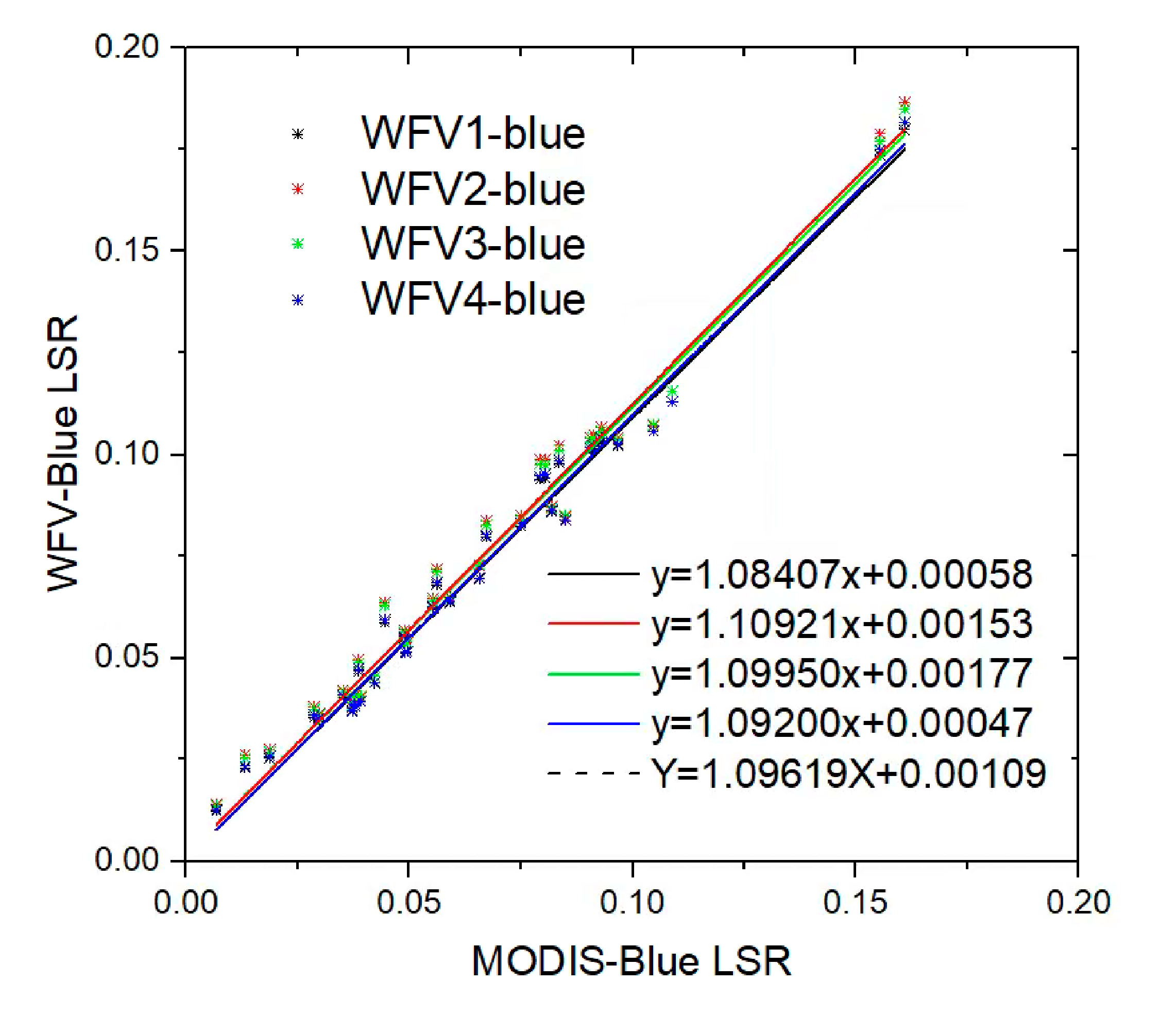
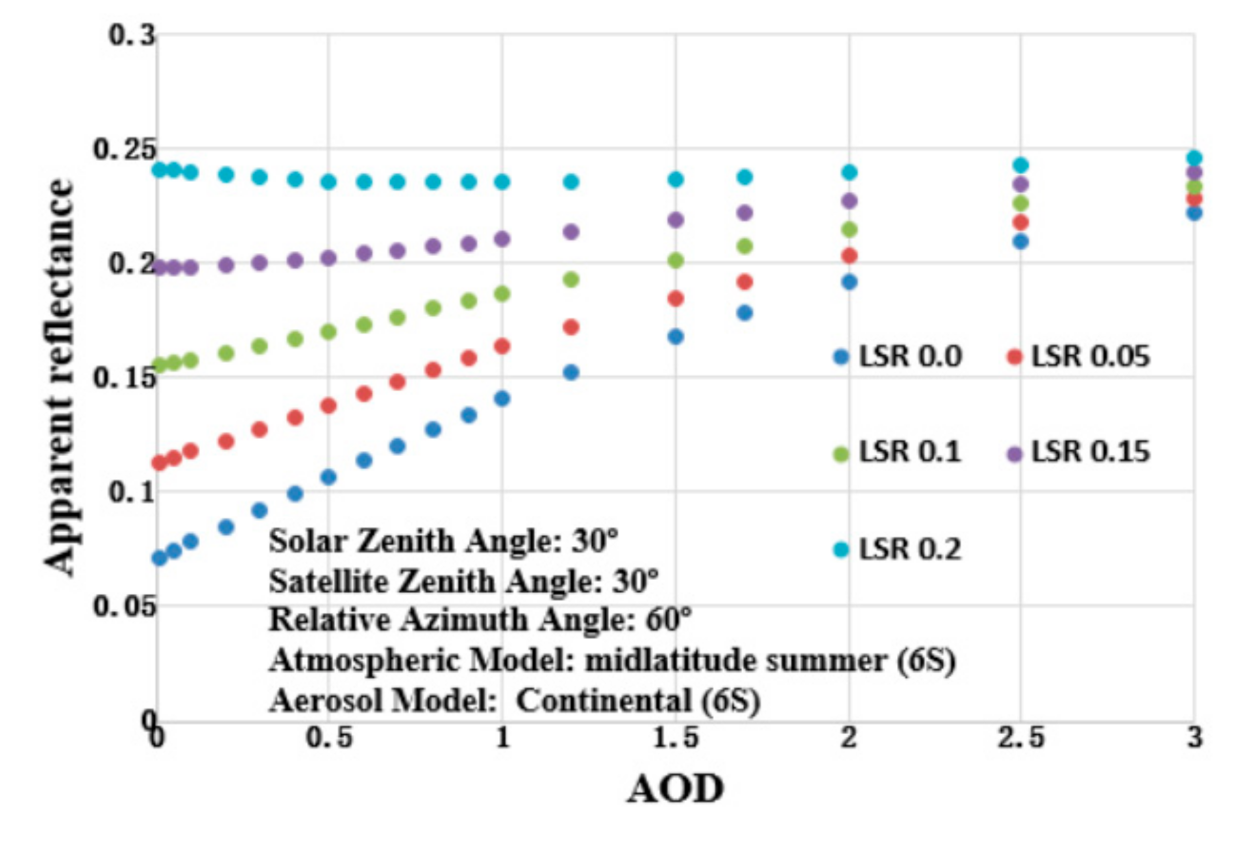
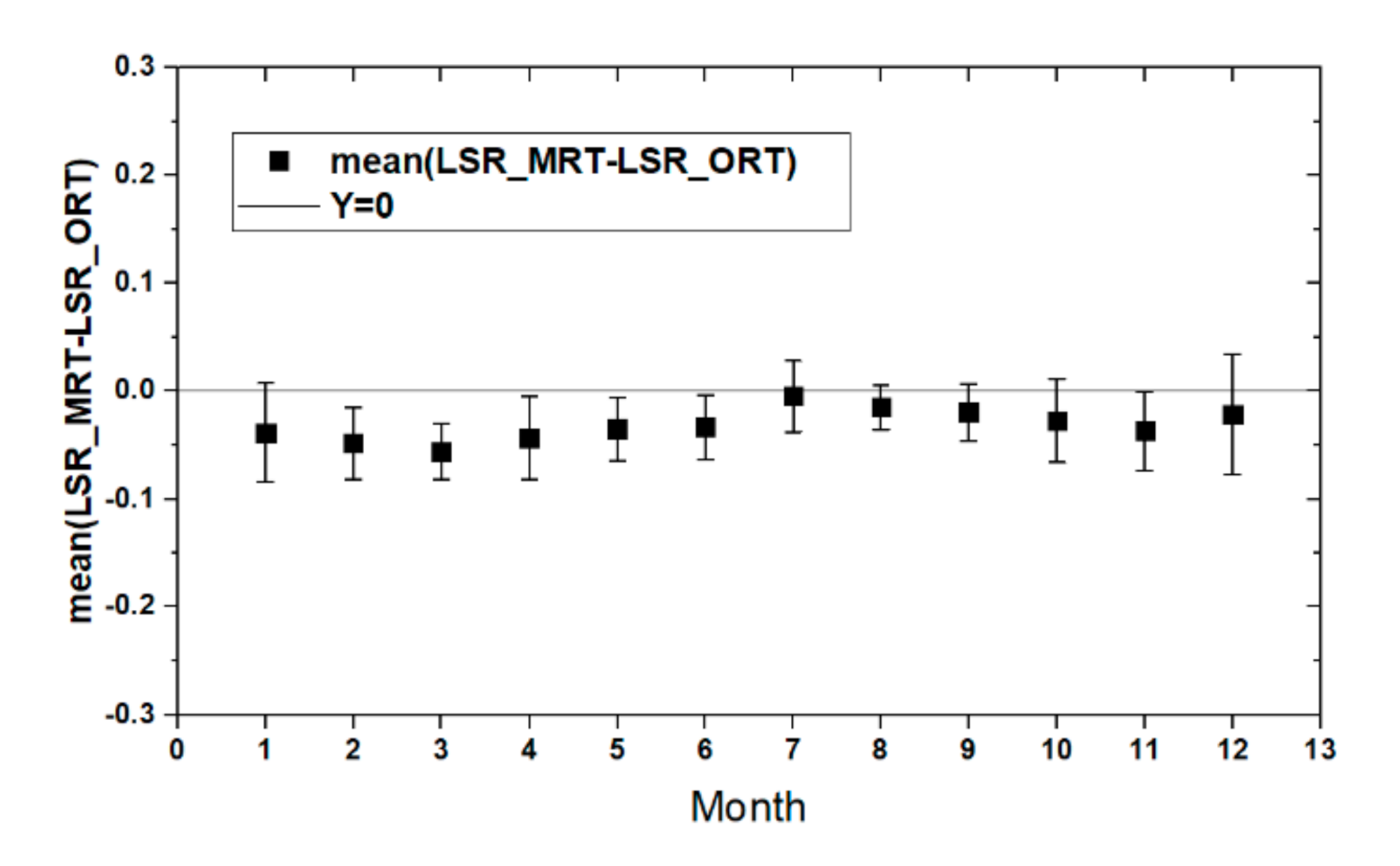

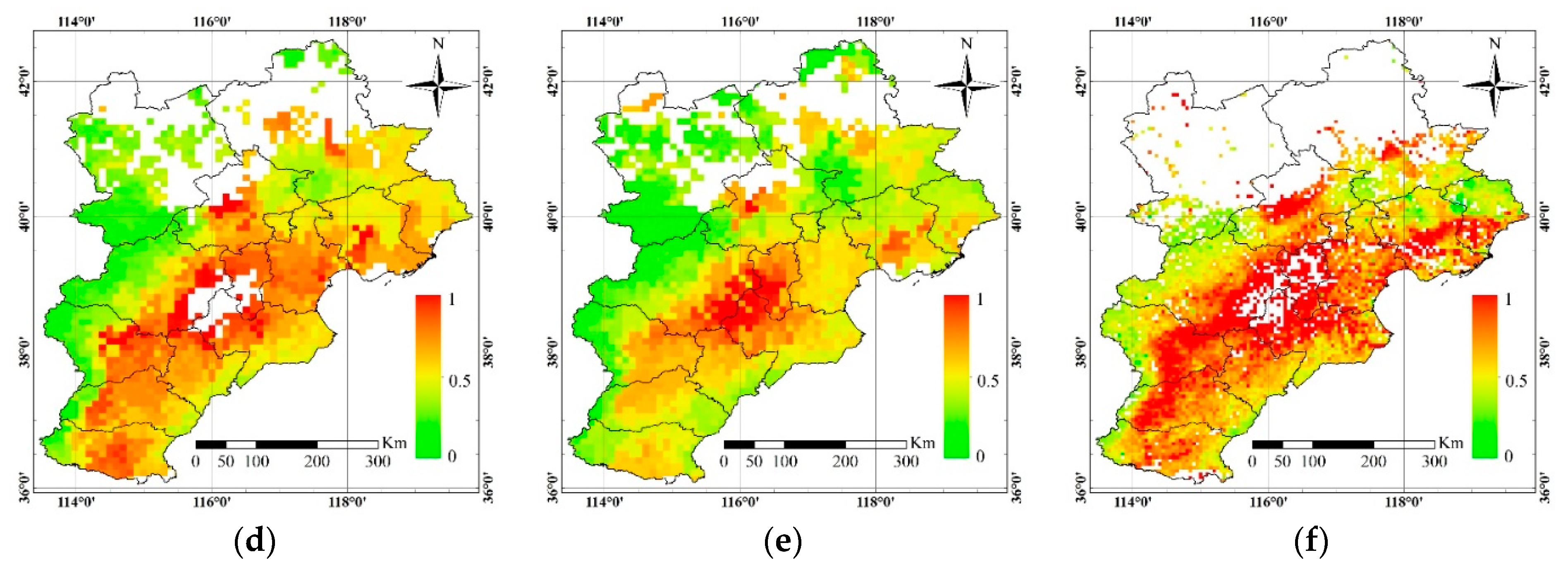
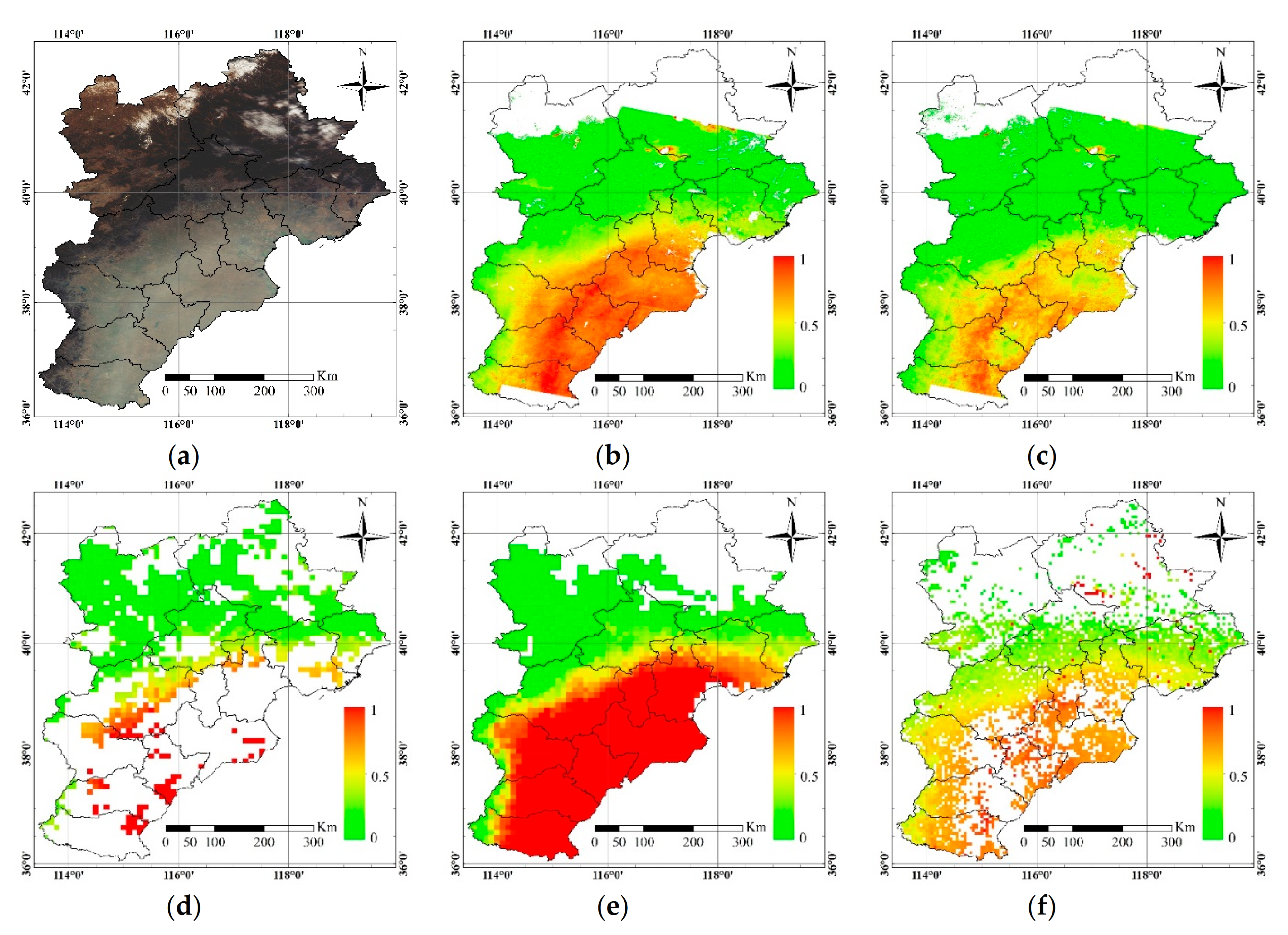

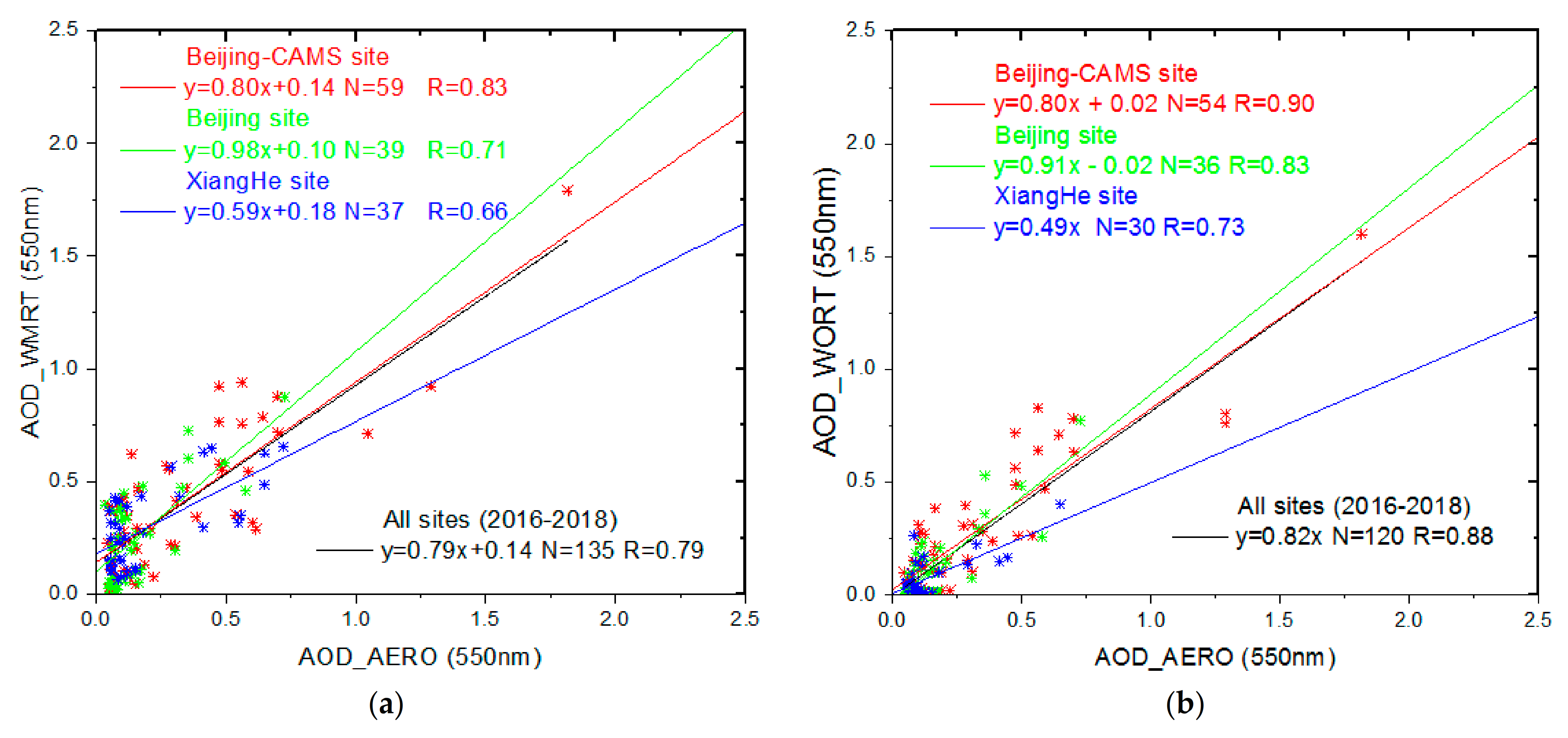
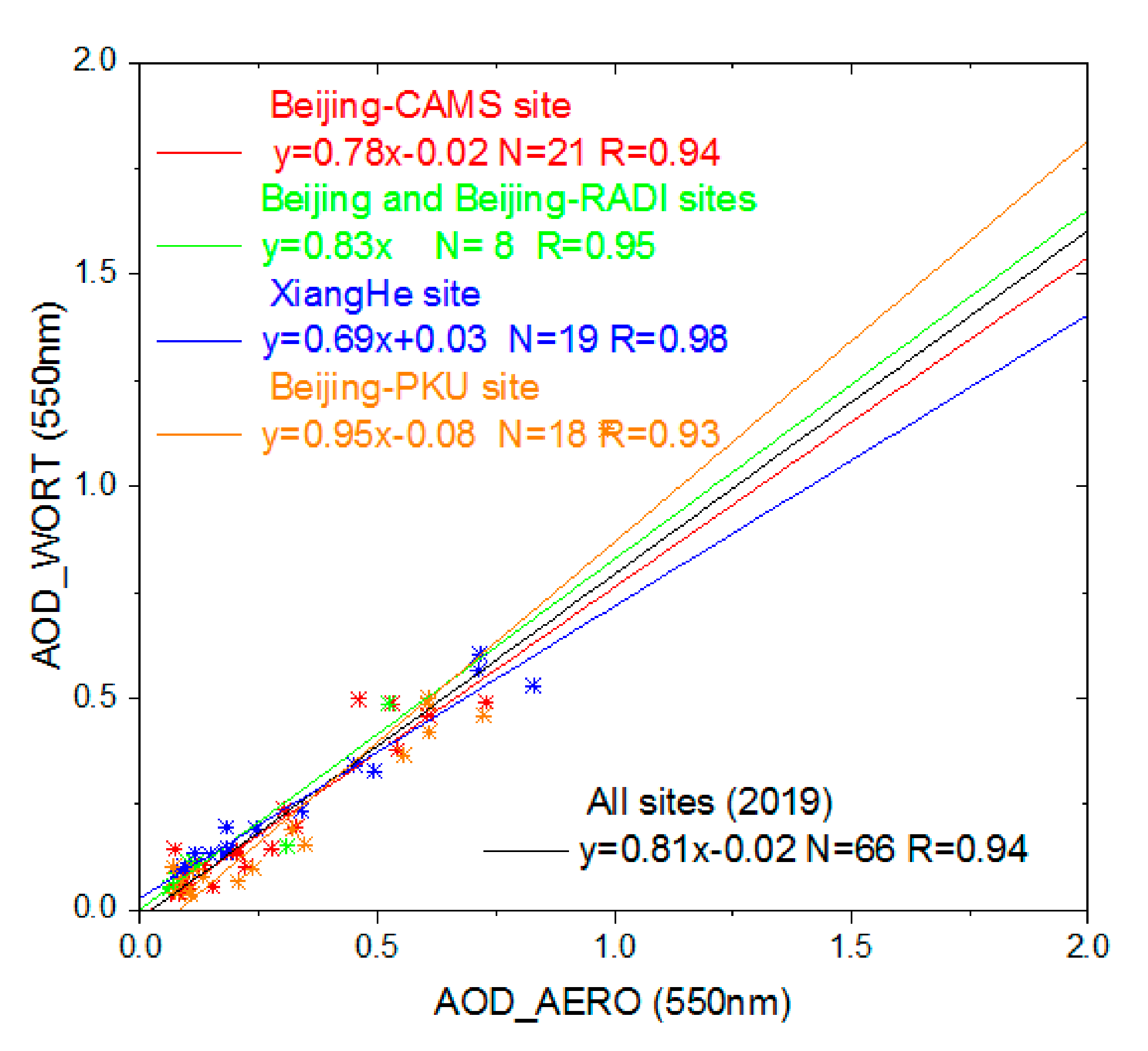
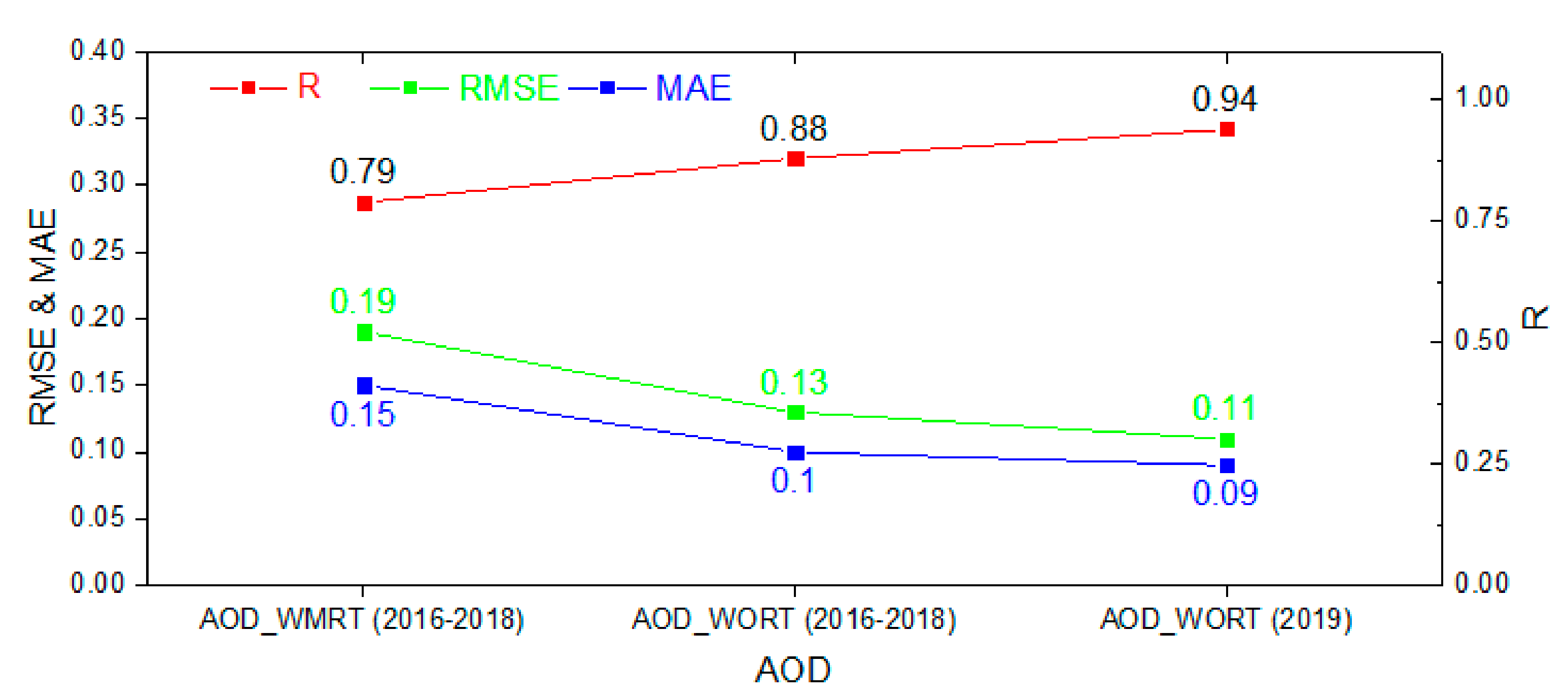
| Sensor | Bands (μm) | Central Wavelength (μm) | View Zenith Angle | Overpass Time | Spatial Resolution | Swath | Revisit Period |
|---|---|---|---|---|---|---|---|
| WFV | E1: 0.45~0.52 | 0.484 | WFV2 and WFV3: 0–24° WFV1 and WFV4: 24–40° | 10:30 LT | 16 m | 800 km | 4 days |
| E2: 0.52~0.59 | 0.560 | ||||||
| E3: 0.63~0.69 | 0.665 | ||||||
| E4: 0.77~0.89 | 0.800 |
| Item | Product Name | Quality Flag (QF) | Spatial Resolution | Usage Purpose | Website |
|---|---|---|---|---|---|
| MODIS LSR | sur_refl_b03 (500 m Surface reflectance Band 3 (459–479 nm)) | 500 m Reflectance Band Quality | 500 m | LSR determination | https://ladsweb.modaps.eosdis.nasa.gov/search/order/1/MOD04_L2--61,MOD09A1--6 (NASA) |
| MODIS DT AOD (AOD_MODT) | Corrected_Optical_Depth_Land | QF = 1,2,3 | 10 km | Spatial distribution contrast | https://ladsweb.modaps.eosdis.nasa.gov/search/order/1/MOD04_L2--61 (NASA) |
| QF = 3 | 10 km | Comprision (2016–2018) | |||
| MODIS DB AOD (AOD_MODB) | Deep_Blue_Aerosol_Optical_Depth_550_Land | QF = 1,2,3 | 10 km | Spatial distribution contrast | |
| AHI AOD (AOD_AHI) | AOT (Aerosol optical thickness at 500 nm) | QA flag (all) | 0.05 deg | Spatial distribution contrast | http://www.eorc.jaxa.jp/ptree/index.html (JAXA) |
| AERONET AOD (AOD_AERO) | Version 3 Aerosol Optical Depth | Level 1.5 (cloud screened) | -- | Validation (2019) | https://aeronet.gsfc.nasa.gov/new_web/data.html (NASA and PHOTONS) |
| Level 2.0 (cloud screened and quality assured) | -- | Validation (2016–2018) |
| Input Variables | Setting |
|---|---|
| Solar Zenith Angle | From 0° to 72° in increments of 6° |
| View Zenith Angle | From 0° to 72° in increments of 6° |
| Relative Azimuth Angle | From 0° to 180° in increments of 10° |
| Atmospheric Model | Midlatitude winter/summer |
| Aerosol Optical Depth | 0.01, 0.05, 0.1, 0.2, 0.3, 0.4, 0.5, 0.6, 0.7, 0.8, 0.9, 1.0, 1.2, 1.5, 1.7, 2.0 |
| Aerosol Model | 6S: continental model and urban model Five models used in the VIIRS over-land: Dust, Smoke-low absorption, Smoke-high absorption, Urban-clean absorption and Urban-polluted absorption |
| Land Surface Reflectance | From 0 to 0.15 in increments of 0.01 |
| A | B | R2 | RMSE | |
|---|---|---|---|---|
| MODIS-WFV1 | 0.00058 | 1.08407 | 0.98665 | 0.00476 |
| MODIS-WFV2 | 0.00153 | 1.10921 | 0.98064 | 0.00589 |
| MODIS-WFV3 | 0.00177 | 1.09950 | 0.98347 | 0.00538 |
| MODIS-WFV4 | 0.00047 | 1.09200 | 0.98483 | 0.00512 |
| MODIS-WFV | 0.00109 | 1.09619 | 0.98303 | 0.00536 |
Publisher’s Note: MDPI stays neutral with regard to jurisdictional claims in published maps and institutional affiliations. |
© 2021 by the authors. Licensee MDPI, Basel, Switzerland. This article is an open access article distributed under the terms and conditions of the Creative Commons Attribution (CC BY) license (http://creativecommons.org/licenses/by/4.0/).
Share and Cite
Yang, F.; Fan, M.; Tao, J. An Improved Method for Retrieving Aerosol Optical Depth Using Gaofen-1 WFV Camera Data. Remote Sens. 2021, 13, 280. https://doi.org/10.3390/rs13020280
Yang F, Fan M, Tao J. An Improved Method for Retrieving Aerosol Optical Depth Using Gaofen-1 WFV Camera Data. Remote Sensing. 2021; 13(2):280. https://doi.org/10.3390/rs13020280
Chicago/Turabian StyleYang, Fukun, Meng Fan, and Jinhua Tao. 2021. "An Improved Method for Retrieving Aerosol Optical Depth Using Gaofen-1 WFV Camera Data" Remote Sensing 13, no. 2: 280. https://doi.org/10.3390/rs13020280
APA StyleYang, F., Fan, M., & Tao, J. (2021). An Improved Method for Retrieving Aerosol Optical Depth Using Gaofen-1 WFV Camera Data. Remote Sensing, 13(2), 280. https://doi.org/10.3390/rs13020280





